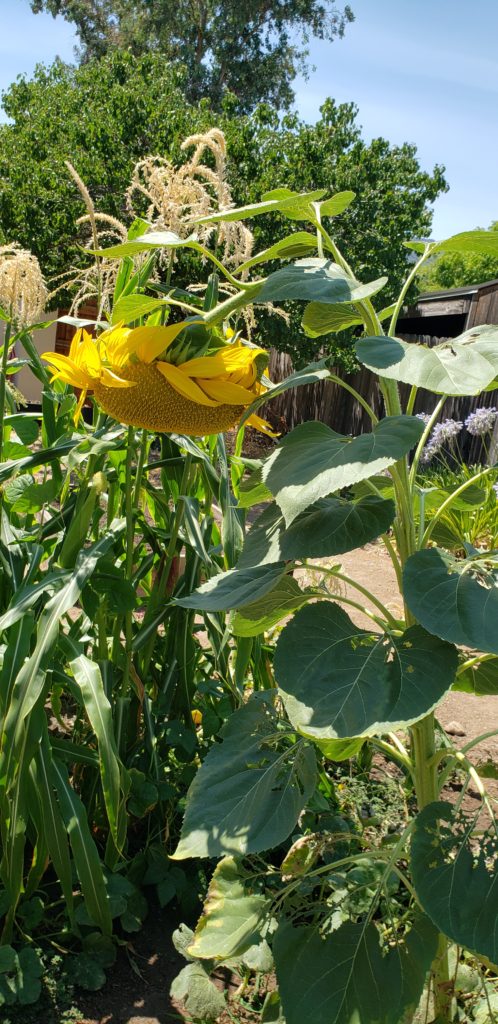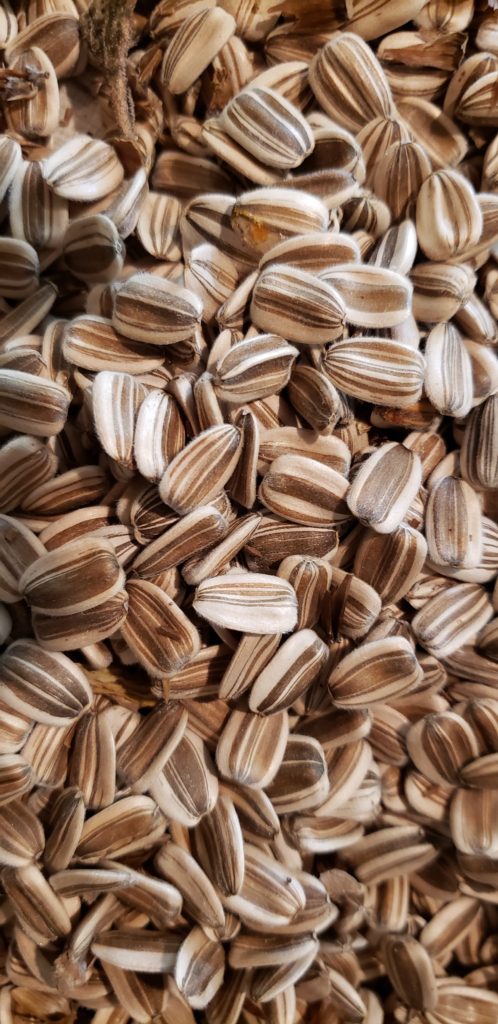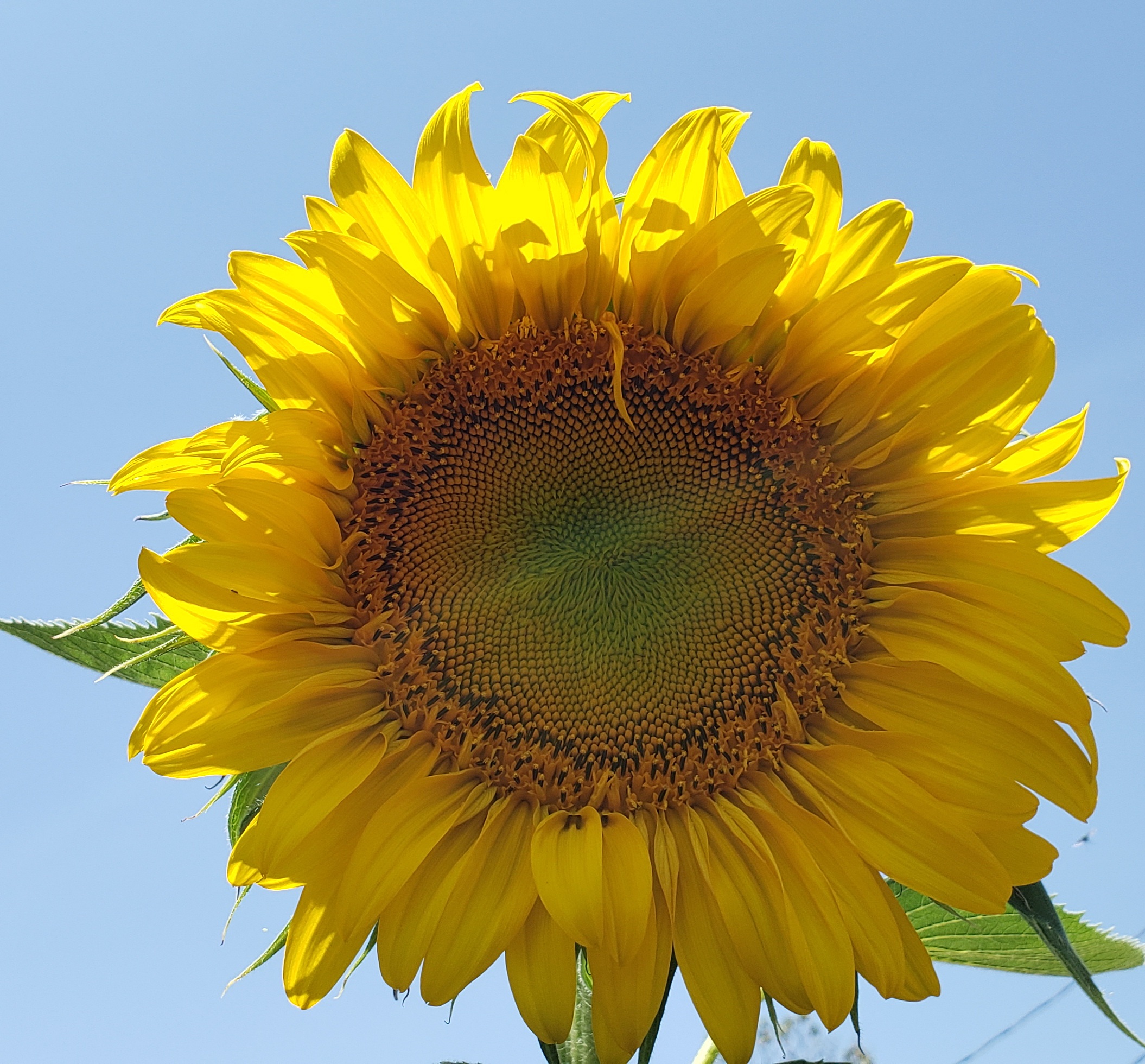This year I learned about a Native American agriculture method called “the 3 sisters.” A culturally significant traditional method of agriculture practiced by tribal communities throughout the Americas, this method embraces the mutualism of 3 crops: corn, beans, and squash. Instead of growing each crop in a separate bed or field, the 3 are cultivated together. The beans provide soil nitrogen for the corn and squash. The corn provides a trellis on which the beans climb and the squash provides ground cover to keep the soil from drying out. Each doing their part.
My 3 sisters grew in a messy mass of foliage. There were no clean rows. The corn is planted early to be strong enough for the beans when they begin to reach out for their climb upward. I planted 2 different varieties of squash as the third sister. My squash seemed to grow happily among the corn and bean sisters.
Amidst my vegetables, I like to grow colorful flowers. This attracts pollinators and provides lovely color to the garden. Sharing its color in the garden this year was a large and healthy sunflower. I didn’t know it at the time I planted my seeds, but there is a 4th sister: the sunflower. Like the corn, a statuesque sunflower can provide a trellis for beans. In my garden this year, the corn anchored the climbing beans with the sunflower radiating its large colorful face on the other 3 sisters.
According to the Farmer’s Almanac, 2021 has been named “The Year of the Sunflower” by the National Garden Bureau. Sunflowers are native to the Americas and were first cultivated by the pre-Colombian Mexican communities.1 Today, sunflowers are cultivated world-wide, mostly for their oil. While the black and white striped seed is harvested for the kernel, the black oil variety is cultivated for its oil.2,3
Sunflowers are hardy plants that are heat and drought resistant. While young, before the seeds appear, a sunflower will move in a light-loving dance to face the sun throughout the day. As the flower matures and bears the weight of growing seeds, the flower’s face remains fixed to the sunrise and instead focuses on the task of seed-making. As the seeds develop, the flower will begin to bow forward with the growing weight of the seeds.4

The sunflower requires patience for the seeds to develop. When the seeds are ready, they separate from the parent flower and fall to the ground for 1 of 2 fates: they might sprout with another generation of sun-worshiping beauty or they might nurture wildlife and fill the bellies of hungry birds. I harvested my sunflower when the first few seeds began to fall to the ground. If harvested too soon, the shells will be empty. If harvested too late, the birds will enjoy full bellies.
Sunflower seeds are a good source of protein2,3,5 but are best known for their oil.3 Sunflower oil is rich in linoleic acid.3,5 Linoleic acid is an omega-6 polyunsaturated type of fat (PUFA) that can be metabolized to produce compounds which facilitate both the inflammatory (arachidonic acid)6 and anti-inflammatory (DGLA through GLA) pathways.7,8
Dietary Linoleic Acid is associated with reduced cholesterol levels7 and may reduce risk of stroke when it replaces dietary saturated fat sources.9 For brain health, effects of dietary linoleic acid is less clear. Tu and colleagues (2019) found that linoleic acid reduced brain inflammation caused by palmitic acid in rodents.10 When combined with zinc, linoleic acid was found to preserve brain neurons in rodents treated with a neuronally toxic pesticide, rotenone.11 On the other hand, another study found that reducing dietary linoleic acid levels reduced an inflammatory compound (arachidonic acid) in brains of rodents exposed to bacterial lipopolysaccharides.12
While Omega 6 linoleic acid may dominate the sunflower fatty acid profile, sunflower oil also contains Omega 9 monounsaturated fat (Oleic Acid) as well3,5 and some crops have been bred to increase the Oleic Acid content of the sunflower oil.13 Dietary Oleic Acid is associated with improved blood lipid profiles14,15 and reduced heart disease risk.15,16
Sunflower seeds are a good source of many vitamins and minerals, including Vitamin E. Vitamin E is a powerful antioxidant that can gobble up free radicals and combat the negative effects of oxidative stress.5
Sunflower seeds contain many plant compounds called phytochemicals, some of which have anti-diabetic properties. For example, sunflower seeds contain a property (Chlorogenic Acid) which is capable of inhibiting a step in the body’s glucose production.2

We may enjoy cracking open salty shell after salty shell to find the seed prize inside and reap the positive blood lipid, anti-diabetic, and cardiovascular benefits found in each kernel. We may get lost in the beauty of the flower, marveling at its amazing stature and wide golden face. Even so, these benefits are not without caution.
Sunflower oil enjoys a high smoke point. A smoke point is the heat at which an oil breaks down. Different oils have different smoke points which makes some oils better for cooking. Despite having a high smoke point, sunflower oil is not ideal for high heat cooking. High heat cooking may cause the production of a toxic substance called an aldehyde. Dietary aldehyde intake is considered inflammatory, neurotoxic, carcinogenic, and can damage DNA and increase cardiovascular disease risk.17 One study looked at the aldehyde production of different oils using deep frying, pan frying, and stir-frying cooking methods. The study results found that sunflower oil produced aldehydes in every cooking method, with the highest aldehyde production associated with deep frying.17
Sunflowers have enjoyed hero status in their contributions to phytoremediation. Phytoremediation is a term for using plants to clean contaminants from soil. For example, sunflowers were planted at Chernobyl to clean up the cesium and strontium found in the soil after the nuclear disaster in 1986.18
What can we learn from the 3 sisters and their radiant 4th sunflower sibling? Perhaps the sisters teach us the meaning of community, a mutualistic collective of living things that share and nurture an ecosystem. Perhaps the sisters teach us the value of cooperation, each contributing their unique talent so the entire community thrives. Perhaps the sisters teach us that living in a tangled mess of diversity outshines a life of similitude. Or perhaps the sisters teach us to respect the ancestral knowledge and lift up the voices of first nation cultures.
Sources
1Lenz, D.L., Pohl, M.D., Alvarado, J.L., Tarighat, S., Bye, R. (2008). Sunflower (Helianthus annuus L.) as a pre-Columbian domesticate in Mexico. Proceedings of the National Academy of Sciences. 105 (17) 6232-6237. doi:10.1073/pnas.0711760105
2Rehman, A., Saeed, A., Kanwal, R., Ahmad, S., Changazi, S.H. (2021). Therapeutic Effect of Sunflower Seeds and Flax Seeds on Diabetes. Cureus. 13(8): e17256. doi: 10.7759/cureus.17256
3Guo, S. Ge, Y., Jom, K.N. (2017). A review of phytochemistry, metabolite changes, and medicinal uses of the common sunflower seed and sprouts (Helianthus annuus L.). Chem Cent J. 11:95. doi: 10.1186/s13065-017-0328-74(Farmer’s Almanac, n.d.)
5Adeleke, B.S., Babalola, O.O. (2020). Oilseed crop sunflower (Helianthus annus) as a source of food: Nutritional and health benefits. Food Sci Nutr. 8(9):4666-4684. Doi:10.1002/fns3.1783
6 Marangoni, F., Agostoni, C., Borghi, C., Catapano, A.L., Cena, H., Ghiselli, A., LaVecchia, C., Lerker, G., Manzato, E., Pirillo, A., Riccardi, G., Rise, P., Visioli, F., Poli, A. (2020). Dietary linoleic acid and human health: focus on cardiovascular and cardiometabolic effects [abstract]. Atherosclerosis. 292:90-98. doi:10.1016/j.atherosclerosis.2019.11.018 7OSU, LPI 2019
8 Kapoor, R. & Huang, Y.S. (2006). Gamma linolenic acid: an antiinflammatory omega-6 fatty acid [abstract]. Curr Pharm Biotechnol. 7(6):531-4. doi: 10.2174/138920106779116874.
9 Veno, S.K., Schmidt, E.B., Jakobsen, M.U., Lundbye-Christensen. S., Bach, F.W., Overvad, K. (2017). Substitution of Linoleic Acid for Other Macronutrients and the Risk of Ischemic Stroke. Stroke. 48:3190-3195. doi: 10.1161/STROKEAHA.117.017935.
10 Tu, T.H., Kim, H., Yang, S., Kim, J.K., Kim, J.G. (2019). Linoleic acid rescues microglia inflammation triggered by saturated fatty acid [abstract]. Biochemical and Biophysical Research Communications. 513(1): 201-206. doi:10.1016/j.bbrc.2019.03.047
11 Mbiydzenyuy, N.E., Ninsiima, H.I., Valladares, M.B., Pieme, C.A. (2018). Zinc and linoleic acid pre-treatment attenuates biochemical and histological changes in the midbrain of rats with rotenone induced Parkinsonism. BMC Neurosci (2018) 19:29. doi:10.1186/s12868-018-0429-
12 Taha, A.Y., Blanchard, H.C., Cheon, Y., Ramadan, E., Chen, M., Chan, L., Rapoport, S.I. (2017). Dietary Linoleic Acid Lowering Reduces Lipopolysaccharide Induced Increase in Brain Arachidonic Acid Metabolism. Mol Neurobiol. 54(6): 4303–4315. doi:10.1007/s12035-016-9968-1
13Jose Maria Fernández-Martínez, J.M., Pérez-Vich, B., Velasco, L., Dominguez, J. (2007). Breeding for specialty oil types in sunflower [abstract]. Helia. 30(46): 75-84 DOI:10.2298/HEL0746075F
14 Jenkins, D.J.A., Chiavaroli, L., Wong, J.M.W., Kendall, C., Lewis, G.F., Vidgen, E., Connelly, P.W., Leiter, L.A., Josse, R.G., Lamarche, B. (2010). Adding monounsaturated fatty acids to a dietary portfolio of cholesterol-lowering foods in hypercholesterolemia. Jenkins DJ, Chiavaroli L, Wong JM, et al. Adding monounsaturated fatty acids to a dietary portfolio of cholesterol-lowering foods in hypercholesterolemia [abstract]. CMAJ.182(18):1961-1967. doi:10.1503/cmaj.092128
15 Allman-Farinelli, M.A., Gomes, K., Favaloro, E.J., Petocz, P., (2005). A diet rich in high-oleic acid sunflower oil favorably alters low density lipoprotein cholesterol triglycerides, and factor VII coagulant activity [abstract]. Journal of the Academy of Nutrition and Dietetics. 105(7):1071-1079. doi:10.1016/j.jada.2005.04.008 16FDA 2018)
17Moumtaz, S., Percival, B.C., Parmar, D. Grootveld, K.L., Jansson, P., & Grootveld, M. (2019). Toxic aldehyde generation in and food uptake from culinary oils during frying practices: peroxidative resistance of a monounsaturate-rich algae oil. Sci Rep 9:4125. doi:10.1038/s41598-019-39767-1
18 The Blackman Lab, UC Berkeley Department of Plant and Microbial Biology. (2013). Bloom of the Week – Phytoremediation with Sunflower. Feb 18. Retrieved from:https://nature.berkeley.edu/blackmanlab/Blackman_Lab/Lab_News/Entries/2013/2/18_Bloom_of_the_Week_-_Phytoremediation_with_Sunflower.html

